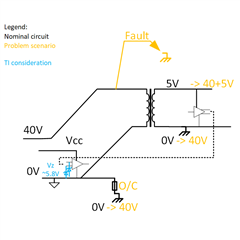Other Parts Discussed in Thread: THVD2412, ISO3080, ISOW1412
Tool/software:
Hello, my organisation has a question about LVDS transceivers which we are using. We have several failures owing to their common-mode weakness. Due to mishandling the system cables, the receiving and transmitting ends find their grounds at significant voltage differences (20-40V) and it results in fried transmitters (DS90LV031AW-QML) and/or receivers (DS90C032E-QML). At system level this causes painful disassembly and repair across multiple modules. Typically aside from loss of function, we see 100-200 mA increased supply current per IC.
Accidents happen. Are there ways to strengthen against such problems: placing resistors, diodes or current limiters to control it?
Does TI have experience understanding the failure mechanism of excess common mode difference?
While I can't provide schematics, the Vcc would be 5, with positive biasing by e.g. 3k-100R-1k on the receiving side.
regards,
Chris



